Lucinda Backwell
Lucinda Backwell (born 1966) is an archaeologist and a member of the Academy of Science of South Africa.[1] She obtained her MSc in palaeoanthropology (cum laude) from the University of the Witwatersrand Medical School in 2000. Her PhD in palaeoanthropology was awarded in 2004, making her the first South African woman to be awarded a PhD in palaeoanthropology at a local institution.[2]
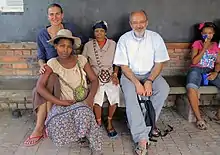
Lucinda Ruth Backwell | |
|---|---|
.jpg.webp) | |
| Born | September 2, 1966 |
| Nationality | South Africa |
| Alma mater | PhD, Msc University of the Witwatersrand University of Bordeaux |
| Scientific career | |
| Fields | Paleoanthropology, archaeology |
| Institutions | University of the Witwatersrand |
| Thesis | Early Hominid Bone Tool Industries (2004) |
| Doctoral advisor | Lee Berger Francesco d'Errico |
| Website | www |
In 2011 she was promoted to senior researcher at the Evolutionary Studies Institute of the University of the Witwatersrand[3], where she taught introductory courses on human evolution and taphonomy and supervised postgraduates on various topics, including fossil assemblages from caves in the Cradle of Humankind.[4] In 2017 she moved to Argentina and became associated with Instituto Superior de Estudios Sociales[5] (CONICET)[6], Argentina. She has been published 40 times and has been involved in 11 documentaries. Her research interests include taphonomy, archaeology, paleontology and ethnoarchaeology.
Research interests
- Vertebrate taphonomy and the fossil record
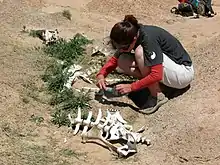
- Early hominin cultural and behavioural evolution
- Tracing the emergence of modern human behaviour
- Correlating archaeology, palaeontology and climate change
- Ethnoarchaeology amongst Kalahari San
- Origin(s) of ritual mortuary practice
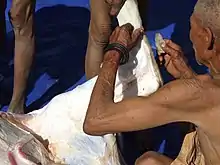
Main fields of specialisation
- Origin and evolution of bone tool technology
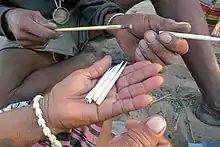
- Microscopic analysis of bone surface modifications
- San material culture, past and present
Current research

- Border Cave Middle Stone Age site excavation and analysis, KwaZulu-Natal, South Africa.
- Working on a book, digital archive of a century-old collection of traditional San material culture, and subtitled film of Kalahari San elders describing in their own words, and demonstrating the use of the items, now housed at Museum Africa in South Africa.
- Experimental taphonomy: ongoing invertebrate modification of bone in South Africa.
- Experimental taphonomy: Refining the functional interpretation of early hominin bone tools: new experiments and texture analyses.
- Longitudinal studies of modern mammal carcass modification, disarticulation, dispersal and burial in a semi-arid grassland environment in South Africa.
- Description of Middle Stone Age bone artefacts from Sibudu Cave, South Africa.[7]

- Holocene mortuary practices in Northwest Argentina.
.jpg.webp)
Books
d’Errico, F. & Backwell, L.R. (Eds) 2005. From Tools to Symbols. From Early Hominids to Modern Humans. Proceedings of a conference in honour of Professor Phillip Tobias. Wits University Press.[8]
Research reports
Backwell, L.R. 2008. Report on 2005 – 2007 excavations at Wonderkrater, a late Quaternary spring and peat mound site in Limpopo Province, South Africa. Submitted to South African Heritage Resources Agency (SAHRA).
Backwell, L.R. 2008. Report on 2005 – 2007 excavations at Heelbo I, a large mammal mass death assemblage in Free State Province, South Africa. Submitted to South African Heritage Resources Agency (SAHRA).
Thesis and dissertation
Backwell, L.R. 2004. Early Hominid Bone Tool Industries. PhD submitted by publications. University of the Witwatersrand and University of Bordeaux I.
Backwell, L.R. 2000. A Critical Assessment of Southern African “Early Hominid Bone Tools”. Unpublished MSc. University of the Witwatersrand.
Documentaries
- 2014 YouTube documentary the San ostrich trap
- 2013 A Shaman's Journey. The last elders [Le voyage de Kgonta Bo, le chaman].[9] Documentary film produced by MC4, with the participation of France Télévisions and Planète Thalassa for France 5 Television.
- 2012 San material culture PNAS podcast on YouTube.
- 2008 Department of Science and Technology. Progress of Science, Human Origins Education (SABC 1)
- 2004 National Geographic Society
- 2003 African Solutions (SABC 3)
- 2002 Cradle of Humankind World Heritage Site (Discovery Channel, Canada)
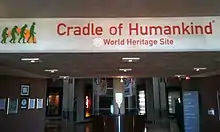
- 2001 Discovery Channel (Canada)
- 2001 Technologic (Summit TV, DStv Ch 412)
- 2001 Cradle of Humankind World Heritage Site
- 2001 Odyssey of Mankind (Zweites Deutsches Fernsehen)
Awards/recognition
- “Best 1st year Lecturer” by Wits University School of Geosciences Geological Student Society. (2014)
- Journal of Archaeological Science Top cited article 2007–2011. (2012)
- NRF rating: C1 (valid 2012 – 2017). (2011)
- Promoted to senior researcher. (2011)
- Voted “Best Lecturer for 1st year”, by Wits University School of Geosciences Geological Student Society. (2010)
- Voted “Coolest Lectures for 1st year”, by Wits University School of Geosciences Geological Student Society. (2010)
- Voted “Best 1st year Lecturer”, by Wits University School of Geosciences Geological Student Society. (2009)
- FEI Prize (Life Sciences) for the best paper on electron microscopy published in an international journal. *“Probable human hair found in a fossil hyaena coprolite from Gladysvale cave, South Africa.” (2009)[10]
- Science Direct 6th most downloaded paper in first quarter for Journal of Archaeological Science. (2009)
- Top 100 Science Stories, Discover Magazine. (2008)[11]
- Certificate of Appreciation, Life Sciences Educators, Teaching and Learning Services, Department of Education, KwaZulu-Natal, South Africa (2008)
- First South African woman to be awarded a PhD in palaeoanthropology at a local institution. (2004)
- University Postgraduate Local Merit Scholarship. (2003)
- University Council Postgraduate Scholarship. (2002)
- University Postgraduate Merit Award. (2002)
- S2A3 Medal. Presented by the South African Association for the Advancement of Science: Most distinguished master's degree in the Faculty of Science for 2000. (2001)[12]
- Top 100 Science Stories Discover magazine: “Evidence of termite foraging by Swartkrans early hominids”. Proceedings of the National Academy of Sciences. (2001)
- University Council Postgraduate Scholarship. (2001)
- Postgraduate Merit Award. (2001)
- MSc. in Palaeoanthropology (cum laude), University of the Witwatersrand Medical School. (2000)
- Postgraduate Local Merit Scholarship. (2000)
- University Postgraduate Merit Award. (2000)
- Category A Award for 2000. (200)
- Lystrosaurus Shield: Best student paper presented at the 11th Biennial Conference of the Palaeontological Society of Southern Africa.
References
- "Members". www.assaf.org.za. Retrieved 2019-02-06.
- "Staff Profile - Lucinda Backwell". University of the Witwatersrand. Retrieved 8 February 2019.
- "Staff - Wits University". www.wits.ac.za. Retrieved 2019-02-06.
- "Lucinda Ruth Backwell". South African Heritage Resources Agency. Retrieved 6 February 2019.
- "Final Permit Report on Archaeological excavations conducted at Border cave 2015-2018" (PDF). SAHRA.ORG. 2018-08-18. Retrieved 8 February 2019.
- "CONICET | Buscador de Institutos y Recursos Humanos | datos académicos: Backwell Lucinda Ruth". conicet.gov.ar (in Spanish). Consejo Nacional de Investigaciones Científicas y Técnicas. Retrieved 8 February 2019.
- Ruth Schuster (25 April 2018). "Earliest Bone Arrowhead, 61,700 Years Old, Found in South Africa". Haaretz.com. Retrieved 6 February 2019.
- "From Tools to Symbols". Wits University Press. Retrieved 6 February 2019.
- Kate Thompson-Gorry (2013). "Le Voyage de Kgonta Bo, le chaman". Film documentaire (in French). Retrieved 6 February 2019.
- "University of the Witwatersrand Research Report 2009" (pdf). www.wits.ac.za. University of the Witwatersrand. 2009. p. 206. Retrieved 19 June 2020.
- Rice, Jocelyn (2008-12-07). "#89: Archaeologists Find the World's Oldest Arrowheads". Discover Magazine. Retrieved 2020-06-19.
- "Medal for Original Research at Masters Level". Home. Retrieved 2020-06-19.
External links
- Lucinda Backwell's personal website
- Publications by Lucinda Backwell at ResearchGate
- Lucinda Backwell publications indexed by Google Scholar
- People by Lucinda Ruth Backwell, at SAHRA